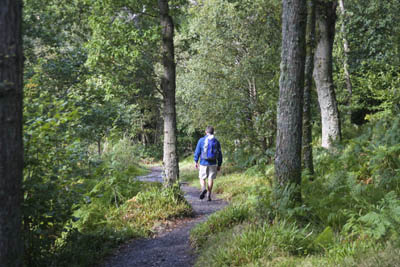 Six hundred and ninety-three years and 222 days ago, King Robert the Bruce struck a blow for Scottish freedom when he banished the English forces from the Stirlingshire countryside with a decisive victory at the Battle of Bannockburn.
Six hundred and ninety-three years and 222 days ago, King Robert the Bruce struck a blow for Scottish freedom when he banished the English forces from the Stirlingshire countryside with a decisive victory at the Battle of Bannockburn.
It was the beginning of a move to self determination that, almost seven centuries later, meant the Scots could take charge of their own destiny in ways not possible in the English shires.
Access in Scotland: under attack again
The right of every Scotsman and woman, or indeed English, Welsh, Norwegian or Zimbabwean visitor to roam the countryside was enshrined in the lauded Land Reform (Scotland) Act 2003.
Now, a landowner just a couple of miles from the site of the defeat of Edward II’s army is seeking to banish the public from his newly acquired estate just outside Stirling.
In a case with unwelcome echoes of Ann Gloag’s victory at Kinfauns Castle, property magnate William Roddie has erected six-foot fences and ‘keep out’ signs at his land at Sauchieburn.
Stirling Council, still fighting an action over Euan Snowie’s Boquhan estate, has ordered Mr Roddie to take down the fences and accompanying gates which it says have been built without planning permission. The fences block a route which has been popular with walkers for generations and which, according to the 2003 act, is access land.
The case first came to the council’s attention in April last year, when it was reported that the locked gates had appeared, along with a number of private signs. In December 2007, council officers reported that, in addition, trees had been felled across the path, anti-climb paint added to the top of fences and screws placed in the top of fences to deter anyone climbing them.
Notices warn that the fence around Sauchieburn House is electrified, even though this is not the case. Other signs have been put up which guide walkers away from Sauchieburn House and towards a waymarked path.
During a site visit, Mr Roddie told council officials he had been ‘having problems with a jogger carrying out stretching exercises on his lawn’. Central Police confirmed it had investigated allegations of a minor assault in December last year, but there was insufficient evidence to bring any charges. Sports coach David Armour, a local resident, said he was confronted by Mr Roddie while jogging through the estate.
The owner also says he has been verbally abused by members of the public passing through, and that cyclists were riding at speed through an area used by Riding for the Disabled.
The council says about 10 acres of the estate can be exempted from access by the public, but Mr Roddie is unhappy with this view, saying it represents only seven per cent of the land. Officers recommended that negotiations continued to resolve the issue but, if no solution was found by the end of January, then enforcement action be started under the Land Reform Act provisions.
Mr Roddie bought the property for a reputed £2m last year. Under the ownership of its previous occupant Gay Stafford, who died in 2006, there had been no access problems.
Stirling Council has confirmed it has served Mr Roddie with notice of enforcement action under sections 14 and 15 of the act.
Twenty-four complaints have been made about the blocking of access. Former MP and MSP Dennis Canavan is supporting the council’s action. Mr Canavan is now president of the Rambler’s Association in Scotland.
Mr Canavan told Scotland on Sunday: “The council is of the view that these locked gates are unlawful and they block a path that has been used by local people to get to the crags. This is a good path compared to a diversion he wants you to take which takes you away from where you want to go up a very muddy track.”
The Ramblers Association in Scotland said it would be pressing Environment Minister Mike Russell to introduce powers to enable councils to take more rapid enforcement action.
In 2005, Mr Roddie was ordered to pay £3m in a divorce settlement brought by his wife Angela. He runs Spectrum Properties (Scotland) Ltd, founded in the East End of Glasgow in 1988 and which describes itself as one of the city’s largest landlords, dealing in offices, workshops and industrial units.
fight to roam
02 March 2008any chance of a grid ref. on this and similar stories? - then we can veer towards hotspots like this on otherwise dull weekends...
grough editor
03 March 2008Sauchiburn House is at NS 774 892
stephanie roddie
23 May 2008i think william roddie is a lovely man.he is ma dad and noone should be saying this about him. none of yous know half the story . my dad did not PUNCH a joggger he told him to beat it and tapped him in the head.before this incodent we were having trouble with dennis canavin sooo please leave us alone and respect our wishews thankyou stephanie roddie
Paddy h
16 June 2014I can understand Stephanie, I don't know your father and most people would hate strangers walking past their home so could your family not provide a suitable path with plant or hedge coverage to help protect everyone's privacy, but what about the horse center surely this is a matter for everyone these children deserve more from their landlord they should be given the right to buy this land or the Scottish government should compulsory purchase the land and access road.